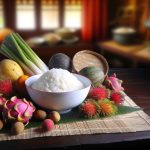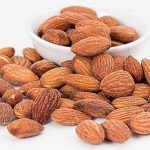Producing sprouts from certain seeds and nuts is an inexpensive and easy way to incorporate additional nutrients into one’s diet. Microgreens which are easy to grow at home, are the ultimate local superfood. You can grow a small batch of sprouts right on your kitchen counter, even if you don’t have space for a garden.
Sprouts
The process of sprouting seeds or beans to create sprouts is called germination. Sprouts can be eaten raw or cooked, depending on the type of plant. Sprouts can be a great addition to salads, stir-frys, and other dishes.
Many types of nuts, grains, and seeds can be sprouted at home using minimal equipment.
The sprouting process makes it easier to digest beans and seeds, and also increases their nutritional value. I explain why in more detail here, but here’s the idea:
Benefits of Sprouts
Plants start with seeds! Seeds are a source of nutrients and energy for plants, which are stored until the plant is able to grow.
When seeds germinate, the sugars are broken down into carbohydrates, which is an important energy source for the growing plant. During the first few days of germination, the proteins in the seeds change into peptides and amino acids, making them more digestible and nutritious.
This means that the nutrients in the food are able to be used by the body.
Contrary to popular belief, germination does not increase the nutrition in the seed. The germination process leads to a number of physical and chemical changes, but the nutrients in the seed remain the same in the sprout.
Some health boosting compounds found in sprouts and microgreens are polyphenols, minerals, and vitamins – all three falling under the category of micronutrients. Micronutrients are nutrients that we need in relatively small quantities, but they are generally more difficult to get than macronutrients, like protein and carbohydrates.
Just like the plants themselves, different sprouts have different benefits, but have some health benefits in common:
1. Lower Anti-Nutrients and Phytic Acid
The process of sprouting helps to break down the naturally occurring anti-nutrients in nuts, grains, and seeds that can make them difficult to digest, especially for those with underlying digestive or autoimmune issues.
Phytic acid is an anti-nutrient which can bind to minerals like magnesium, zinc, calcium, and iron, making them harder to digest. This allows the seeds to go through an animal’s digestive system without being harmed and then grow into a plant.
Although this is good for the seeds, it is not as beneficial for people trying to get nutrients from their food.
This problem is solved by breaking down anti-nutrients, enzyme inhibitors, and lectins. Soaking and sprouting grains for even one day can reduce the anti-nutrient content by up to 90%.
Simultaneously, germination increases the abundance of many advantageous nutrients and amino acids by making them more accessible to the body.
Ever gotten gas from consuming beans? If you eat soaked and sprouted legumes, you’re less likely to have problems with digesting them or with gas.
2. Polyphenols
There are over 500 types of polyphenols, which are micronutrients found mainly in plants. It is more beneficial to consume polyphenols with foods that also contain healthy fats, as this allows the body to absorb more of the nutrients.
Polyphenols are molecules that have a large phenolic group- a hydroxyl group that is bonded to a benzene ring. They are good antioxidants. The important micronutrients we get from plants are biochemically very important.
Researchers found that the total polyphenol content in sprouts was directly related to the amount of antioxidant activity in cells. So, eat your sprout polyphenols to up your antioxidants!
3. More Beneficial Enzymes
Raw vegetables have one tenth of the amount of enzymes present in sprouts. The enzymes in rapidly growing sprouts are beneficial for us because they are necessary for the sprouts’ own growth and cellular health.
Sprouts contain enzymes that help protect against cancer-causing chemicals.
4. Creates Protective Compounds
The compounds in sprouts help protect the body in various ways. Sprouts are packed with nutrients and eating them is equivalent to eating the entire plant. By consuming sprouts, you are getting all the benefits that come with eating that plant.
Antioxidants and enzymes in sprouts help keep cells healthy and stop damage from free radicals. Different types of sprouts support the body in various ways:
- Broccoli sprouts contain sulforaphane, a cancer-fighting compound that has been extensively studied. Sprouts contain 10-100x as much sulforaphane than adult broccoli plants and are often recommended for this reason.
- Alfalfa sprouts are quick growing and a good source of vitamins C and K, as well as B-vitamins. They are also a source of saponins, which are said to help balance cholesterol and support the immune system.
- Most sprouts are a good source of hydrolytic enzymes that help the body assimilate food.
- Clover sprouts are a good source of isoflavones.
- Sunflower sprouts are high in protein, phytosterols, essential fatty acids, and fiber.
- Lentil sprouts are an excellent source of protein and a great way to consume lentils.
Microgreens Nutrition Info
Sprouts are great for you, but microgreens are even better.
In a study first-authored by Dr. Zhenlei Xiao, it was shown that microgreens frequently have higher concentrations of vitamins in their tiny leaves than in mature vegetables.
Next time you’re reaching for sprouts at the grocery store, stop and consider one of these incredible microgreens stats:
- Vitamin K1 (phylloquinone) is much lower in mature amaranth, basil and red cabbage than in those vegetables’ microgreens. Vitamin K also seems to play an important role in preventing heart disease and is essential to blood clotting and bone health. Vitamin K also activates a protein that helps prevent calcium from depositing in your arteries. 18 out of 25 microgreens tested had equal or higher amounts of K1 than adult broccoli!
- Vitamin C (ascorbic acid) in red cabbage microgreens is 6 times higher than adult red cabbage. Vitamin C is necessary for the growth, development, and repair of all body tissues. It’s involved in many body functions, including the formation of collagen, absorption of iron, the immune system, wound healing, and the maintenance of cartilage, bones, and teeth
- Most microgreens had comparable amounts of beta-carotene to carrot and sweet potato, both considered to be abundant sources of beta-carotene. Beta carotene is a precursor of vitamin A, which we need for healthy skin, mucous membranes, immune system functioning, and good eye health and vision. Cilantro microgreens even have three times as much beta-carotene as adult cilantro, while red cabbage microgreens have 260 times as much beta-carotene as adult red cabbage!
- Lutein and zeaxanthin are higher in sorrel, red cabbage and garnet amaranth than in adult spinach
- Cilantro microgreens has more than 5 times the violaxanthin that mature cilantro
- Even in microgreens that had the low vitamin E (gamma-tocopherol) relative to other microgreens, they still had more vitamin E than adult spinach
Sulforaphane in Broccoli Sprouts
Some doctors and nutritionists say that broccoli sprouts are one of the best sources of the cruciferous vegetable isothiocyanate sulforaphane.
If you want to live a long and healthy life, Dr. Rhonda Patrick recommends eating sprouts often. This is because they contain high levels of sulforaphane, which is a powerful antioxidant.
The highest levels of sulforaphane in broccoli plants are in the ungerminated seeds. However, you can get the next best thing by eating broccoli sprouts and microgreens.
The manner in which food is cultivated is pivotal for both the sustenance of the environment and the food’s nutrient concentration. This also applies to sulforaphane found in broccoli sprouts.
Different temperature levels cause different growth levels in broccoli sprouts, which in turn affects the amount of healthy compounds in the sprouts.
The amount of glucoraphanin and sulforaphane increase as the growth temperature increases. Dr. Rhonda Patrick demonstrates how to increase the sulforaphane content of your sprouts by three times by gently heating them for only a few minutes!
Most compounds in natural foods will vary, but there is some consensus about how much sulforaphane is in dried broccoli sprouts: about 1100 milligrams / 100 grams.
Broccoli seeds and sprout extracts have a bioavailability of around 30%. However, research has shown that microgreens have a bioavailability of 30 to 60%.
This means that microgreens are not only more nutritious than sprouts, but that their nutrients are also more easily absorbed by the body.
Soaking vs. Sprouting
Soaking nuts, beans, and seeds in a mixture of warm water and an acidic substance like lemon juice can help reduce the level of harmful compounds present.
Sprouting is an extension of soaking. An acidic environment is not usually used in order to allow the seed to germinate and begin to grow. Beans should always be soaked before consuming, but they don’t necessarily need to be sprouted.
Some plants, such as seeds and nuts, grow best when they are sprouted.
Microgreens vs. Sprouts
- Microgreens have amazing flavors and vibrant colors since they’ve developed true leaves, while sprouts are usually mild-flavored and colorless
- Microgreens have higher concentrations of many micronutrients than mature vegetables and sprouts
- Microgreens are much less likely to grow toxic bacteria since, unlike sprouts, they’re not grown in a dark and humid environment
- Microgreens have at least as much nutrient bioavailability as sprouts, and in some cases they have much higher nutrient bioavailability
Microgreens are very healthy and taste great.
Best Things to Sprout
- Most nuts (except pecans and walnuts)
- Most grains (if you consume them)
- Most seeds including broccoli, pumpkin, sesame, chia, radish, alfalfa, broccoli, red clover, sunflower, and others
- Most beans – lentils and mung beans are the most common for sprouting
A few notes:
- Red kidney beans should not be sprouted as they contain a toxic compound once they sprout. They can be soaked but must be cooked before eating.
- A few nuts, like pecans and walnuts, do not sprout and are better to soak.
- Alfalfa seeds are a controversial plant to sprout as they contain canavanine, which some sources say are harmful to humans because it can inhibit the immune system. (Though this article gives a good explanation of why alfalfa sprouts may be perfectly safe.)
- Chia, hemp, and flax seeds do not typically sprout well, though they can be through very precise methods (I recommend growing them as microgreens instead).
Problems With Sprouts
There has been some negativity surrounding sprouts in the past as they have been known to contain bacteria that can cause food poisoning. In the past, they have been connected to outbreaks of salmonella and E. coli. Chickens are often kept in cramped, unsanitary conditions, which can lead to the spread of disease. So are sprouts too dangerous to eat?
The bacteria that cause illness are often found on the seed itself. Proper preparation and sprouting methods can help avoid problems.
You can also find seeds that have undergone bacteria testing, which could potentially lower the chances of problematic bacteria.
To reduce the chances of getting sick from eating sprouts (again, a rare occurrence):
- Wash or sterilize the jar or vessel used for sprouting before each use.
- Take care to wash hands and any surfaces near the sprouts.
- Follow a proper rinsing schedule to minimize risk.
Conclusion
Although sprouts may contain bacteria that could cause food poisoning, they also offer many health benefits. Eating meat or eggs is more likely to cause illness than eating sprouts, but sprouts can still cause illness.
Make sure to do your own research before consuming sprouts so you are aware of the risks and benefits.
READ MORE: Health Benefits Of Sprouted Grains









